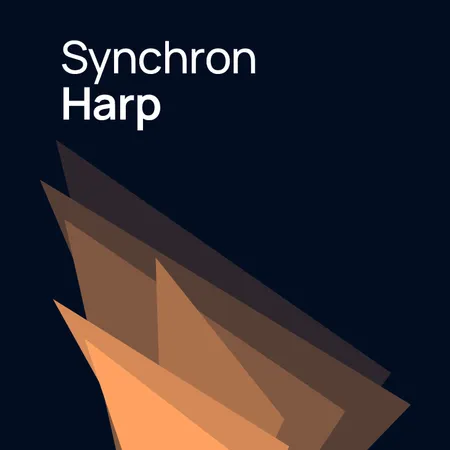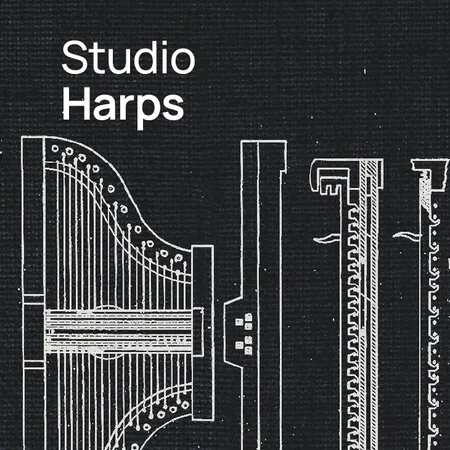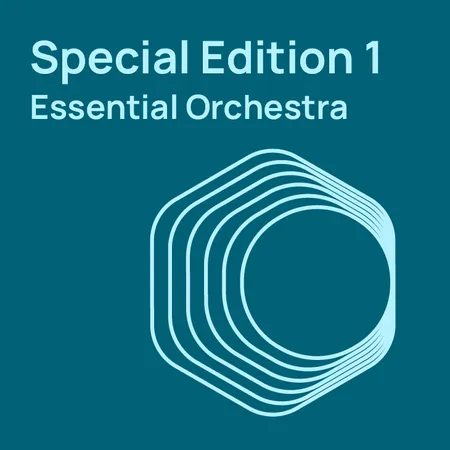
Name: Harp
Spelling
German: Harfe
French: harpe
Italian: arpa
Classification: Composite chordophone (stringed instrument), plucked instrument
Soundbox: Approx. 145 cm long, maple; flat soundboard, five sound holes on the underside.
Neck: Curved, made of maple
Head with crown: Material: Wood or metal; joins the pillar to the neck
Pillar: Approx. 183 cm high, maple, hollow, contains the rod mechanism (connecting wires for altering string pitch)
Strings: 47 strings made of gut, steel, copper, nylon; tuned diatonically in Cb major. Cb strings are colored red, Fb strings blue. Longest string: 150 cm, shortest: 7 cm; string tension 700-1400 kgf
Foot and pedal box: Maple, contains 7 pedals
Weight: Approx. 35 kg
Tuning: Approx. equal temperament
Thanks to its "universal character", the harp is one of the oldest and most widespread musical instruments known to man. Harps may come in a variety of shapes and sizes but they all have three components in common: the soundbox (body), the neck and the strings. In 1914 the Berlin musicologists Ernst Moritz von Hornbostel and Curt Sachs defined harps as follows: a harp is any stringed instrument whose string plane is vertical to the soundbox. This is true of both triangular and rectangular instruments as well as those with a simple mechanism or a complex one.
Defining the harp's role in culture is not so easy: it is by nature diatonic and was used in many cultures to accompany poets and singers. In the ebb and flow of its development it has had its place in all classes of society, fulfilling a multitude of functions: as a folk instrument and instrument of worship, to accompany dancers or singers and minstrels and last but not least as a sculpture laden with symbolic meaning in the salons of 19th century aristocrats.
The name of one of the harp's typical playing techniques, the broken playing of chords, was derived from the name of the instrument itself: arpeggio . Broken chords are now called arpeggio even if they are played on, say, a clarinet.
In recent years composers have begun making far more effective use of the harp, which has resulted in the development of a great many new playing techniques and sound effects.
In modern orchestral and concert playing the double-action pedal harp has established itself, a model first developed in around 1820 by Sébastien Erard in Paris.
Discover our Harps
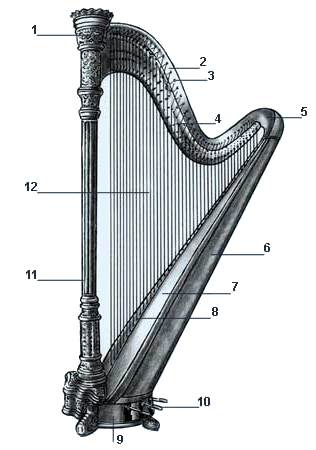
1 head; 2 neck; 3 tuning pins; 4 discs; 5 shoulder; 6 body; 7 soundboard; 8 suspension rod; 9 pedal box; 10 pedals; 11 pillar; 12 strings
The body (soundbox) is roughly the shape of a half cone, and has a larger diameter at the base (near the bass strings) than at the top (near the high strings). The body is larger near the bass strings so that they have the required resonance. There are five sound holes on the underside of the rounded body through which the sound is projected. The flat soundboard is made of spruce and 10 mm thick; it has three functions: to absorb the string pressure, to transfer the vibrations from the strings to the soundbox and to project the sound. The strings are attached to the suspension rod, which lies on the soundboard, at an angle of 36 degrees to it. A reinforcing board runs parallel to the suspension rod inside the harp.
The neck sweeps up and forward like a snake and is often decorated with animal or human-like mythological figures.
On the outer edge are the tuning pegs and two rows of rotating discs (the upper and lower discs). The pegs can be turned with the aid of a tuning wrench and serve to tune the strings in preparation for playing.
The mechanism that operates the discs is inside the neck and is used for altering the pitch of the strings during playing. This mechanism is activated by seven pedals. By depressing a pedal once the upper disc is turned, its pins touch the string and shorten it, raising its pitch by a half tone. If the pedal is depressed a second time it locks in a lower notch and turns the lower disc, raising the pitch of the same string a further semitone. In other words, the pitch of each string can twice be raised by a half tone.
When a pedal is operated the corresponding note is retuned in all six and a half octaves, because the discs turned by one pedal movement are connected to each other by wires and therefore react simultaneously. The strings are between the neck and the body.
The pillar has two tasks: on the one hand it stabilizes the frame and on the other it contains the rod mechanism in its hollow interior. The rod mechanism consists of hinged rods which transfer the pressure on the pedals to the pegs on the neck.
The center of gravity is contained in the foot and gives the instrument stability when it is not being played. The foot also houses the seven pedals, one pedal for every note of the diatonic scale. By operating a pedal each octave of a note is retuned. The left foot operates the Cb, Db and Bb pedals, the right foot the Eb, Fb, Gb and Ab pedals.
The Near East and North Africa form the cradle of one of the oldest musical instruments known to man for which evidence, particularly in the form of grave paintings, can be traced back 6,000 years. The illustrations in the tomb of Ramses III (1200 BC) show the oldest and most common type of ancient Egyptian harp, the arched harp.
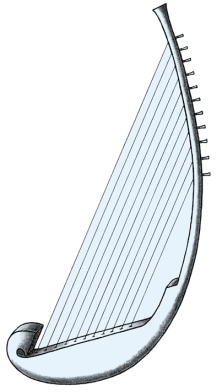
*Arched harp*
The arched harp is characterized by the curved neck, which forms a crescent-shaped arch with the body.
The flat soundbox (body) mostly took the shape of a shovel or spade. The 6-12 strings were stretched at the lower end of the instrument between the fixed pegs on the neck and a suspension rod attached to the body. The soundboard was made of wood or animal skin. The instrument was often decorated with a carving, depicting the head of a bird, for example.
The musicians (harpists) are usually shown in the sitting position, the instrument's soundbox resting on the ground, the upper part leaning against the shoulder. These early harps were already played with both hands.
Many illustrations show harps, often several at a time, together with other instruments such as the lute, the drum and the double pipe. Both male and female harpists are depicted, some of whom are giving hand signals which are evidently intended to direct the way the music is being played; in other words, they are early conductors. At this time the harp was only played at solemnities and religious festivals and was not used at dances until later.
In around 2000 BC a new type of harp emerged which probably originated in Asia: this was the angular harp, characterized by the straight neck at right angles or a sharp angle to the body.
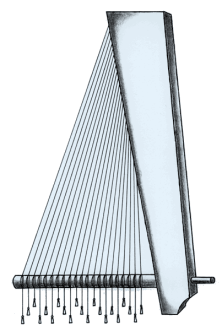
*Angular harp*
The suspension rod was connected to the wood soundbox and covered in leather. The strings were attached to the suspension rod's leather covering at one end of the harp. At the other end they were wound round the neck and tied to pieces of twine to make them longer and easier to tune. The leather-covered soundbox was hollow and was strengthened by struts inside it. The cylindrical string arm was set at an acute or right angle to the body. It was customary to have up to 20 strings. A homogeneous sound was produced by virtue of the fact that the lowest string was about four times as long as the topmost one.
The first evidence that the harp was becoming known in Europe dates from the 8th century AD and is found in Ireland and Scotland. It is possible that the harp was introduced into these countries from Scandinavia. Later on it spread to the European mainland where it was known as the cithara anglica and replaced the lyre. The oldest harps still in existence were found in Ireland and France and date from the 14th century. In Christian iconography harps are usually depicted in connection with the Biblical King David, where they became known as "Davidic harps". The name "hearpan" is first mentioned in around 1000 AD.
But it was a new model, the so-called frame harp, from which all later European harps up to the modern-day double-action harp evolved. The frame harp was characterized by an additional front bar (or pillar), which formed a more or less triangular frame together with the body (soundbox) and the neck. The pillar helped supporting the heightened tension of the strings which stretched between the neck and the soundbox. Frame harps could be either triangular or rectangular, the triangular form being the more usual. Early medieval harps had between seven and nine strings, later models between 20 and 25. The strings were made of gut or metal, the gut strings being played primarily with the fingertips, the metal strings with the fingernails. "Irish harps" could have as many as 43 metal strings.
Information on playing techniques is hard to come by. Strings were presumably retuned, half tones were produced by pressing the strings onto the neck, harmonics by plucking a string and touching it lightly in the middle at the same time. It is possible that harpists alternated between fingertip and fingernail playing to achieve a different timbre for melody or accompaniment tasks.
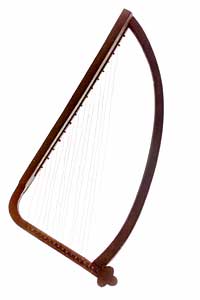
Frame harp
One common peculiarity deserves a mention, as it served to attain the sound ideal prevalent in the late Middle Ages: hook-like pins were frequently attached to the body of the harp (soundbox) in such a way that the strings struck it during playing. This resulted in a vibrating, rattling sound (snare). This rattling effect remained widespread until Renaissance times.
In courtly life the harp, which counts as one of the quieter instruments, was used chiefly to accompany balladeers and dancers. It was equally popular with the higher social classes (the king and the high nobility) and professional musicians (bards, troubadours, minnesingers, itinerant minstrels) who earned their living by performing love songs and heroic ballads.
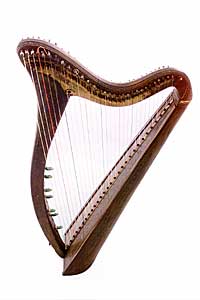
Renaissance harp
From the 15th century onward the harp's development was to some degree dependent on that of keyboard instruments (organ), since there are certain similarities between the way the notes are arranged and the playing techniques. Efforts to improve the instrument focused mainly on the extension of the bass register. Two methods were adopted to achieve this: either the neck was curved upward and the pillar elongated to achieve the length of string required; or the neck length was retained and the lower end of the body extended, which put the pillar at a more acute angle to the body but a more obtuse angle to the neck. Renaissance harps were about 100-105 cm tall, had 25-26 gut strings and were no longer played with the fingernails but with the fingertips. The diatonically tuned strings had a range from F2-C6. The fourth string (B) or the seventh string (E) were often tuned to a half tone lower. The pitch could be raised by a half tone during playing by pressing the string down at the neck with the left thumb or index finger.
In the late Renaissance, music became more and more chromatic and in the 16th century efforts were made to turn the diatonic harp, whose range was increasingly felt to be lacking, into a chromatic instrument. The double harp (or two-rank chromatic harp) was developed. The double harp found use as a thorough-bass instrument (also in Claudio Monteverdi's operas).
Double harps had strings on two levels which were arranged parallel to one another. One level was diatonic while the other included the chromatic degrees. In the middle range the diatonic and chromatic levels alternated: the diatonic notes in the lower register were on the left hand side (so the left hand played the lower strings), the chromatic notes were on the right. In the upper register, the province of the right hand, the positions were reversed; the diatonic notes, which were used more frequently, were on the right, the chromatic notes on the left. This meant that both hands could remain in their natural position and play both rows of strings, reaching the chromatic strings through the diatonic ones.
Instruments of this type had around 60 strings (about 33 on the left hand side and 26 on the right). Cross-strung instruments and harps with three ranks of strings (triple harps), which could have as many as 100 strings, were also constructed.
Toward the end of the 18th century the single-action harp replaced the double and triple harps after both models had existed side by side for some time.
In 17th century Austria a significant step in the further development of the harp was accomplished by unknown folk musicians in the Tyrol: the hook harp was fitted with hooks on the neck near the tuning pins which made it possible to shorten the strings, raising their pitch by a half tone. These hooks were originally fitted to those strings which had the most half tones, but later they were added to every string. Although there could be no doubt that it was an enormous advantage being able to turn the hooks to retune quickly, the disadvantage was that the musician had to stop playing with one hand to do so. The number of strings was reduced to about 48 as against the chromatic harp and the instrument was tuned to C major. The principle of retuning became widespread in Europe and was still used on diatonic harps into the 19th century. Instruments of this type were especially popular with folk and street musicians.
Thanks to this function and the invention of the pedal which followed soon after, the harp had succeeded once and for all in maintaining its status as a diatonic instrument, albeit one with considerable chromatic capabilities.
The first single-action pedal harps were made in around 1720 by Jakob Hochbrucker in Bavaria. The pedals, which initially numbered five and later seven, made it possible to raise the pitch of the diatonically tuned strings by a half tone. All the strings with the same note were worked by one pedal, in other words activating the pedal raised a particular note in every octave simultaneously; it was not possible to raise the pitch of one note individually. Furthermore, raising the pitch by a half tone (shortening the string) could only be done once. Because the pedals could be operated by the feet, both hands remained free to play the strings.
In the 18th century the fundamental tuning was Eb major (Ab major and Bb major were also common).
The following eight major keys could be played on a pedal harp tuned to Eb major: Eb, Bb (Ab raised to A), F (Eb raised to E), C (Bb raised to B), G (F raised to F#), D (C raised to C#), A (G raised to G#), E (D raised to D#). W. A. Mozart wrote his double concerto for flute, harp and orchestra in C major, K. 299, for an instrument of this type.
This single-action pedal harp was exported to France where, 100 years later, it was further developed to make a double-action pedal harp.
In 1820 the brilliant Parisian piano maker Sébastien Érard produced the first double-action pedal harp, the modern-day harp. On his instrument every string could twice be raised by a half tone. This was achieved by placing each string over two rotating discs, each of which had two pins. Every disc could be turned by operating a pedal: one pedal movement moved the upper disc, raising the pitch by a half tone, a second pedal movement turned the lower disc and raised the pitch a further half tone. In this way it was possible to play in all twelve keys. The strings were tuned to Cb major and the 48 strings had a range which covered a total of over six octaves. It is on this principle that modern double-action pedal harps are based.
This new technology increased the number of possible playing techniques; new playing techniques and sound effects - such as glissando over a diminished seventh chord - were soon part of the repertoire not only of the soloist and chamber musician but also of musicians in the orchestra.
From the middle of the 19th century the harp, often in a group with several others, successfully established itself as an integral part of the orchestra.
As with the piano harp notation is written on two staves and is non-transposing. The lower staff is in bass clef, the upper in treble clef. If required by the register both staves can be in the same clef, either bass or treble.
Harmonics are indicated by a small circle over the note and sound an octave higher than written.
Changes in pedal position should also be written into the score and are most conveniently effected during rests, so that the musician has sufficient time to prepare them.
Range of the harp: Cb1 - G#7
The 47 strings are tuned diatonically and produce the fundamental scale of Cb major. Every string therefore has a different pitch. The long (bottom) strings are near the foot, furthest from the musician, the short (top) strings near the neck, nearest the musician.
The harp is played in the sitting position, the upper part of the instrument's body resting against the right shoulder. The foot rests on the floor. The instrument is played by both hands: the right hand plays the short strings, the left hand the long ones. Depending on the musical context both hands can be active over the entire range.
The strings are plucked in the middle with the fingertips. This is called striking. Striking the string in the middle produces the fullest sound. Près de la table denotes attack near the soundboard, which results in a sound that contains more partials, is brighter, more metallic and almost like a guitar.
Sons étouffés are notes which are damped by the flat of the hand.
Harmonics are produced by placing the ball of the hand on the middle of the string while the same string is plucked in the middle with the thumb.
When playing chords up to four notes per hand are possible. A reach of up to a tenth is normally possible, larger reaches are more difficult.
There is one pedal for each of the seven notes of the fundamental Cb scale. Each pedal can be depressed twice; depressing a pedal to the first notch raises the pitch of the corresponding string in all octaves by a half tone (the string is shortened): depressing it to the second notch raises the pitch a further half tone. In other words, the pitch of each string can be raised twice, each time by a semitone, which results in an increase of a whole tone.
Raising the Cb string to C with one pedal movement raises the pitch of all the Cb strings by a half tone; a second pedal movement raises all the Cb strings by a total of a whole tone. All the pedals work according to the same principle. It is not possible to change the pitch of one string only.
The notes Db in one octave and D in another are not playable, since only the Db string can be raised to D. The next lowest string, Cb, cannot be raised by three half tones. The same is true of the notes Gb with G and Ab with A. This means that the pitches D, G, and A can be produced on one string only.
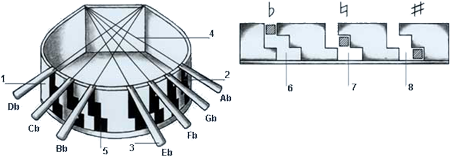
**Pedal box**: 1 Left foot; 2 Right foot; 3 Eb pedal; 4 Retuning wires; 5 Pedal positions
**Pedal positions**: 6 Normal position; 7 Depressed once; 8 Depressed twice
If the musician wishes to use, say, the pitches C and B in a glissando (both pitches should be playable at the same time with no pedal shift) he or she has two possibilities: either the Bb pedal is used to retune to B and the Cb pedal to retune to C, or the Bb is retuned to C and the Cb pedal is left in its original position.
Depressing all seven pedals at once retunes the fundamental key from Cb major to C major; depressing them all a second time raises the pitch to C# major.
Three pitches are available on every string, so 21 pitches are available from the seven steps of the diatonic scale. This means that almost every one of the twelve notes of the chromatic scale is available twice (2 x 12 = 24), with the exception of the three pitches D, G and A.
Notes of the same pitch which can be played on adjacent strings are also known as synonyms. Synonyms can be used for special combinations of scales and chords which are extremely effective when played glissando. A so-called bisbigliando effect (piano tremolo on two adjacent strings) also results.
It is therefore possible to play in all keys on the double-action pedal harp. Composers must give the musician time for modulations in distant keys (by using rests), because time is required to operate the pedals. It is for this reason that fast chromatic scales cannot be played on the harp. It is only possible to play excerpts of chromatic scales consisting of a few notes. These are used chiefly for embellishment.
Chords, passages, playing in octaves, figurations, arpeggios and glissandos are among the instrument's most typical playing techniques. Because of the harp's diatonic character longer chromatic passages can only be performed with great difficulty, if at all. In every register a series of three successive chromatic notes can be played with no change of pedal; four successive chromatic notes are possible four times; and five are only possible once.
It should be noted that a maximum of two pedals can be operated at the same time.
This is the harp's quintessential playing technique. Arpeggio is the broken playing of a chord, the playing of its notes in succession. Chords can be played either ascending or descending, monophonically or polyphonically, or with one or two hands.
A series of adjacent strings are sounded by the fingertips in one smooth movement. The number of different notes per octave that sound (between four and seven are possible) and which scale (major, minor, whole-tone scale, pentatonic scale) or chord (major seventh, minor seventh, diminished seventh) is determined by the position of the pedals.
Several glissando variations are possible:
Monophonic: The example below demonstrates a heptatonic glissando.Reverberate: this reverberation is generally damped. The lower the note, the longer the reverberation.
Short, vigorously plucked and damped.
Damped with the finger or the flat of the hand immediately after striking.
Played near the soundboard. These notes contain more partials and therefore sound brighter, more metallic, more like a guitar and more diffuse than notes played in the middle of the string, which have a fuller sound.
Produces a harder, metallic sound which contains a higher number of partials.
Plucking the strings with the fingernail. This technique was used in the Middle Ages and the Renaissance period, as well as in the "Irish" style. In 20th century music fingernail playing represents a special sound effect.
Fast and slow vibrato is possible on one string. Pitch and intensity fluctuate.
The repeated striking of the same pitch, either on the same string or on two strings. Because of reverberation repetitions on the harp are usually played on two strings which are tuned enharmonically to the same pitch.
When playing chords up to four notes per hand are possible. The hand can reach across eleven strings, which corresponds to an eleventh. If the upper string is raised twice by two pedal movements a twelfth results. Larger reaches than this should not be asked for. Fingers one to four are used as playing fingers. (1st finger = thumb; 2nd finger = index finger; 3rd finger = middle finger; 4th finger = ring finger). The 5th finger (little finger) is used only for the four-part glissando.
Chords are either played plaqué, in other words all the notes are sounded simultaneously, or as an arpeggio, with the notes being played smoothly and in quick succession in one direction, either ascending (from low notes to high) or descending (from high to low).
Trills performed with one hand can only be played slowly. With two hands they can be played very fast.
The rapid repetition of two notes. This can be either monophonic or polyphonic.
Basically the rapid repetition of two notes. If two strings are used which are tuned enharmonically to the same pitch and are played piano, they are described as bisbigliando (whispering). What is particularly appealing about the bisbigliando sound is that one string can continue ringing while the other is plucked.
The production of an overtone by placing the ball of the hand on the middle of the string while the string is plucked at the same time. As a rule the second partial (octave) sounds. Depending on where the string is pressed and plucked notes as far as the fifth partial can be played.
(20th century music)
- Allowing one string to rebound against another
- Glissando on one string with tuning wrench (a wrench used to retune the strings)
- Pedal trill, pedal glissando
- Hitting the strings with a stick
- Striking the body or soundboard
Here's an example for pedal glissando:
Gentle, metallic, blurring, resonant, short, hard, drifting, full-sounding, rushing, clear, brilliant, glittering, flowing, dull, mellow, sharp, crystal clear, reverberating, splashing, cascading.
The attack time is short and depends on the length of the string.
Low harp notes take about half a second to develop fully, which is considerably longer than the high notes.
The same is true of the decay time: a low note resonates for four or five seconds, whereas a high note dies away very quickly. To prevent the blurring of harmonies the notes sounded are damped with the hands as far as possible before a new harmony is sounded. There are three instances in which it is customary to damp low notes: when there is time to do so, when this is explicitly required in the score and at the end of a piece. The damping of very high notes is not necessary. The note value written indicates the decay time.
On the other hand, the blurring of the previously played notes with those sounded afterward is an inevitable - and wished for - effect of glissando.
Note
When moving from one harmony to another in the lower register composers should give the harps time to damp the reverberation or the reverberation time to die out.
Cb1 - F#3 (G#3)
Full-sounding notes that resonate for a long time. The low harp notes are often used to replace bells. The bottom strings have sufficient volume and reverberation to carry arpeggios. When playing glissandos, on the other hand, these characteristics result in a blurred overall sound and the lowest harp notes intrude on the glissando and are therefore avoided.
It is principally in this register that bass tasks are performed.
Middle registerGb3 (Ab3) - C#6
A brilliant and warm timbre is characteristic of this register. Notes resonate for one or two seconds. It is chiefly in this register that chords, harmony, arpeggios, glissandos and melody lines are played. If the harp is given a leading role as a melody instrument in this register and has no support from other instruments, the number of the other instruments must be no greater than in chamber music to avoid drowning out the harp's melody.
Upper registerDb6 - G#8
Very bright, hard, short and penetrating notes. Short decay time of the sounded string, but a general resonance develops from the soundbox, a kind of overall resonance of all the strings.
The harp is often used to accompany singing voices and solo instruments. As a thorough-bass instrument it performed bass and harmonic tasks.
In orchestral composition it has retained both these functions: the bottom strings are often used to play the bass voice. The weaving of delicate harmonic sound backdrops (arpeggio technique) is another of its quintessential tasks. In addition, it is the various types of harp glissando that lend the undulations of the orchestra the shimmer of brilliance which is one of the most fundamental sound experiences of them all.
Note
The harp is one of the quiet instruments. In his revision of Berlioz's Instrumentation Theory, Richard Strauss deals with the subject in the following terms: "The harp must always be treated as a solo instrument, even in the orchestra, if one wishes to avoid writing notes that will not be heard."
The harp combines well with all orchestra groups. It has the function of fleshing out the sound and is often treated as a filling-in instrument.
The harp achieves a good blend with the strings because they are related to each other as stringed instruments, although in particular cases it depends on the playing technique used. The string orchestra can be used as a kind of giant harp (pizzicato technique), as often shown by Beethoven in his orchestral works, in which he uses the strings as a harp substitute.
Played in unison or in octaves with the violins a blend with contours unfolds which is especially well suited for melodic or thematic high points. The effect achieved when the harp plays harmonics to the violins in unison or octaves is particularly appealing.
When played in unison these two instruments reinforce each other through their resonance. When playing piano the harp provides a solid bass foundation even without the double-bass and can replace the double-bass's pizzicato, albeit with less volume.
In the middle register the harp doubles the woodwinds' and horns' sustained chords in unison, which produces an extremely mellow effect. Woodwind chords in unison with the harp are one of the key combinations. If the harp plays an octave above the woodwinds in the upper register the harp sounds like an overtone of the woodwinds.
In unison with the flute, harp harmonics blend particularly well. The harp and flute have always been an extremely popular combination, the harp as the accompaniment to the flute melody.
The blend in unison with the clarinet is somewhat more acerbic than with the flute.
In alternating combinations, whether in unison or in octaves, a dark and sustaining effect with clear contours emerges, especially in pianissimo and piano passages, which is well suited as a bass foundation and for bass lines.
Both instruments blend well.
Both instruments blend in unison, although the trombone must play two to three dynamic degrees lower than the harp so as not to drown it.
Here the aim is less a good tonal blend than the complementing of sound and substance. The harp and singing voice are traditionally partners that complement each other, one performing the role that the other is not performing so that two complementary tonal streams unfold. The singing voice has a higher dynamic level than the harp.
Good effect played pianissimo or piano in unison.
The harp in unison and in octaves with the xylophone lends the latter's short and sparkling notes the necessary resonance, while the xylophone lends the harp a certain edginess.
In unison and in octaves in the upper register, chords played by these instruments produce a crystalline, gossamer-like, ethereal effect which is used to evoke fairy-tale atmospheres or to denote dream sequences in opera, ballet and film music.
Ernst Křenek
- Sonate (1955)
Luciano Berio
- Sequenza II (1964)
Benjamin Britten
- Suite (1969)
Ludwig van Beethoven
- Variations on a Swiss folk song for harp or piano
Louis Spohr
- 2 fantasies op. 118 for violin and harp or piano
Camille Saint-Saëns
- Fantaisie, op. 45
Claude Debussy
- Sonata for flute, viola, and harp
- Danse sacrée et profane for harp and strings
Maurice Ravel
- Introduction et Allegro for harp, string quartet, flute, and clarinet (1905)
Paul Hindemith
- Konzertmusik for piano, brass instruments, and harps, op. 49 (1930)
- Sonata
George F. Handel
- Concerto B-flat major, HWV 294 (1736)
Ernst Eichner
- Concerto C major (1771)
Wolfgang Amadeus Mozart
- Double concerto for flute, harp, and orchestra C major, K. 299 (1778)
François-Adrien Boieldieu
- Concerto C major (1801)
Germaine Tailleferre
- Concertino pour harpe et orchestre (1926)
Mario Castelnuovo-Tedesco
- Concertino for harp and chamber orchestra, op. 93 (1937)
Joaquín Rodrigo
- Concerto-Serenade (1952)
Heitor Villa-Lobos
- Concerto (1953)
Witold Lutosławski
- Double concerto for harp, oboe, and orchestra
Hector Berlioz
- Symphonic poems
Franz Liszt
- Symphonic poems, e.g. Dante Symphony
Giacomo Puccini
- All operas
Richard Wagner
- All operas. Siegfried: 6 harps
Gustav Mahler
- Adagietto, 4th movement of 5th symphony (1904)
- 6th symphony a minor (1906)
- 7th symphony e minor (1908)
Claude Debussy
- La Mer (1905): 2 harps
- Jeux (1913)
- Prélude à «l'Après-midi d'un faune»
Anton Webern
- Six pieces for orchestra, op. 6 (1911)
Igor Stravinsky
- The Firebird (1910)
Maurice Ravel
- La Valse (1920): 2 harps
- Daphnis et Chloë (1912)
Béla Bartók
- The miraculous Mandarin, op. 19 (1919)
- Music for Strings, Percussion, and Celesta (Sz 106 / BB 114), 1937
- Concerto for Orchestra (1944): 2 harps
Salvatore Sciarrino
- Grande Sonata da camera
On this page
- Construction
- Body
- Neck
- Pillar
- Foot
- History 1 - Egypt to Middle Ages
- Egypt
- The harp reaches Europe in the Middle Ages
- History 2 - Renaissance to Modern
- The Renaissance and Baroque periods: Attempts at chromatization
- Hook harp: Mechanization
- Single-action pedal harp
- Double-action pedal harp
- Notation
- Range
- Sound production
- Striking technique
- Pedal technique
- Playing Techniques
- General
- Arpeggio
- Glissandos
- Single notes
- Secco
- Étouffer
- Prés de la table
- Plectrum
- Fingernail playing
- Vibrato
- Repetitions
- Multiple fingering
- Chords
- Trills
- Tremolo
- Bisbigliando
- Harmonics
- Modern techniques
- Sound characteristics
- Sound Combinations
- Harp + string orchestra
- Harp + woodwinds
- Harp + brass wind instruments
- Harp + singing voice
- Harp + percussion
- Repertoire (selection)
- Solo harp
- Chamber music
- Concertos for harp and orchestra
- The Orchestral Harp
